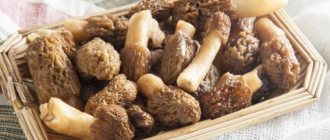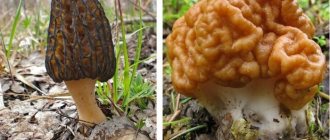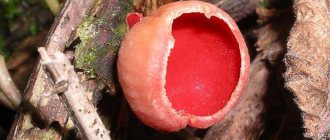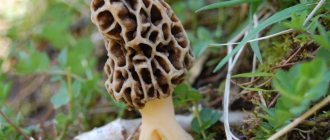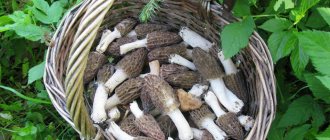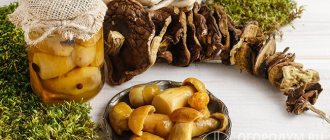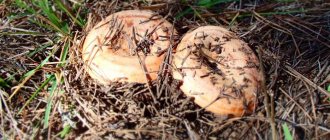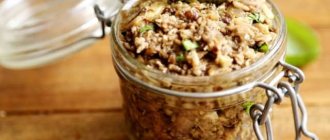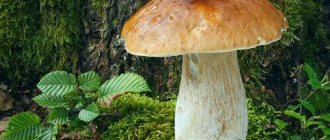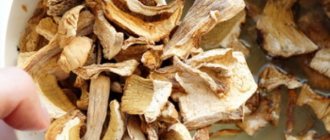Good afternoon, dear readers. In spring, nature gradually reveals its delicious secrets. Therefore, when walking in the forest, be especially careful. Small pieces of off-white, yellow, brown or even reddish velor can turn out to be delicious mushrooms with a strange name - stitches and morels. What do the lines look like, are they edible or not, how to cook the lines, where do they grow, are these mushrooms good or bad, when to collect them? Below are all the answers to the questions and the most delicious recipes for their preparation.
Mushrooms appear from the ground in the spring, the earliest, here they are akin to snowdrops. At this time, there are still no fresh vegetables and fruits, they are just starting to dream about berries, so I really want something fresh, grown in natural conditions, without a greenhouse.
Morel and string mushrooms: where they grow, differences
In appearance, string mushrooms are very reminiscent of the same early spring guest as morels. But it’s enough to look at the photo and description to understand that the main difference is in the hat. Morels are more beautiful, they have a regular shape and deep grooves.
The lines with the appearance were unlucky. Their randomly arranged folds and intricate configurations visually resemble the surface of a walnut, and combined with a dirty appearance, they look ugly. They are practically devoid of legs; they are small and not clearly defined.
Depending on the time of growth, the lines are divided into spring and autumn. The first ones appear as soon as the frosts have gone, of which the plant is not very afraid.
If the cold does catch you, then with the start of warming the mushroom continues to grow, only dark spots on the surface remind of trouble. Found in pine forests and clearings. They love to grow in places of fires and fires.
The autumn mushroom reminds itself of itself in September and October. Prefers forests, most often found in mountainous areas. At this time there are already many other, no less tasty, mushrooms, so we are not so revered.
Treatment of hematopoietic diseases
The beneficial substances contained in these mushrooms are simply irreplaceable for reducing hemoglobin and deteriorating blood counts.
They help strengthen blood vessels and improve their tone. The presence of special components helps thin the blood, which is simply vital to avoid the formation of blood clots. Therefore, treatment with morels is justified for varicose veins, thrombosis, and fragility of blood vessels. This can help avoid hemorrhages, fragility and fragility of capillaries. In addition, dishes made from this herbal medicine increase hemoglobin, combining perfectly with meat products in taste.
Poisonous or beneficial
Many foreign sources classify the mushroom as poisonous. During the Soviet era, string was considered conditionally edible, acceptable for food, but requiring heat treatment.
The main health hazard is gyromitrin, which is part of it, which passes into water or decomposes within 25-30 minutes of boiling. Therefore, mushrooms are added to food carefully and only after special processing.
Spring line: benefit or harm? - fungotherapy - treatment with mushrooms.
Do not confuse edible morels (common morel, conical morel, morel cap) with lines, which in Europe are considered poisonous, but in our country are conditionally edible. Let's try to figure out why this happens and are they actually poisonous? Why are these mushrooms so popular among mushroom pickers, and every year they go to the forest for them? Some mushroom pickers call the lines (gyromitra) “quasimodes” of the mushroom kingdom, and some compare them to the wet faces of Shar-Peis. The lines do not lack healing properties. It has been noticed that many forest inhabitants, as soon as May comes, begin to eat the lines - this is their mushroom treatment. Scientists have discovered substances in the lines that have a number of medicinal properties. It turned out that the stitches are useful for: - joint diseases (arthralgia, rheumatoid polyarthritis, osteochondrosis, radiculitis, arthritic pain, pain due to overgrown bones of the feet) - various diseases of the pancreas - bronchitis, pneumonia - for the treatment of postoperative adhesions - for pain relief in oncological practice . The toxic substance gyromitrin from mushrooms is not completely removed by boiling, and has a pronounced analgesic effect. Therefore, tinctures from the lines are popularly used not only for joint diseases (externally), but also for oncology - in small doses internally. Polysaccharide CE-4, discovered by American scientists, is similar to chondroitin obtained from the joints of ungulates - and we have all heard about the benefits of chondroprotectors for a long time. The line also contains an antirheumatic substance similar in action to cortisone, which has a powerful anti-inflammatory effect. Tincture for joints: fill a jar to the top with lines and fill it with alcohol or vodka, close the lid tightly and place in a dark place for two weeks. Rub the prepared tincture into the affected area, then wrap it up. I do not recommend using the tincture of the line internally: consultation with an experienced fungotherapist is necessary.
Unfortunately, one of the areas of traditional medicine - fungotherapy (mushroom treatment) - is not yet often used in practice, although in recent years it has been successfully developing. Using the example of one type of mushroom - strings (not to be confused with morels) - you can learn the enormous effectiveness of fungotherapy.
These mushrooms are not uncommon, but are more often found in the forest zone of Russia, especially in its northern part. They hatch in mid-April. When the sun slightly strokes the drying soil, the lines already show their tops - real mushroom snowdrops. They are unpretentious and happily take root in any place chosen for them. People love them for their amazing healing properties.
Stitch mushrooms: description
The height of the line is only 6–7 cm, the roundness is no more than 15 cm, the cap is intra-hollow, the surface is sinuous-wavy, brown in color. The leg reaches 6 cm with longitudinal folds. The pulp is brittle, with a specific, weak odor.
Mushrooms grow in flocks, often in pine copses and forests. They should be collected along forest roads, and especially in forest clearings and fires with sandy, non-turfed soil. Harvesting time: mid-April – May.
For information: in France and other Western countries, the lines are separated artificially. For a divorce at home, a site is chosen. They collect dried wood, rotten leaves, stakes from an old fence, etc. Set up a fire pit. The lines are cut into pieces and scattered over the ash. In April next year, only a few mushrooms may appear, but in five years the harvest will be plentiful.
Strings have long been popular as a food product, but they are considered to be conditionally edible mushrooms. Before eating, they should be boiled for a long time, and then fried for a long time. You should also rinse with water before frying. They should be consumed young. This is the only way to eliminate the toxic substance gyromitrin present in them. However, under certain conditions it is an excellent healing substance.
How to cook
When preparing dishes, much attention is paid to preparation:
- The wavy, wrinkled cap collects all kinds of debris and dirt in its folds. When preparing it, it must be carefully cleaned and rinsed under running water for a long, long time, otherwise sand will be present in the finished dish, which is especially unpleasant.
- The mushroom in its fresh state is very fragile, so it is necessary to collect, clean and sort it carefully.
- Before cooking, boil the lines in a large amount of water, approximately 3 liters per 1 kg and boil for at least half an hour. Drain the water; nothing else can be cooked in it, let alone added to food. Rinse the mushrooms in clean water, remove any remaining dirt. If you doubt the quality, for greater guarantee, boil again in clean water for 30 minutes.
Experts advise pre-soaking the gifts of the forests in sauerkraut brine. The taste and smell of the products will become richer, and after two hours of exposure the mushrooms become harmless.
It is believed that it is better to cook mushrooms with sauce, otherwise they may taste rubbery. The product is used to prepare dressings, the delicacy is prepared in sour cream, fried, stuffed with meat, soups are prepared, and preparations are made for the winter.
Method of preparing the tincture
First you need to dry the mushrooms, then chop them. To prepare an alcohol tincture, it is better to take a glass container with a tight-fitting lid.
Mushrooms and vodka are mixed in it in a ratio of 10 g per 150 ml. You need to leave it in the refrigerator for about 14 days. The resulting tincture is applied to a sore spot on the body. Be sure to cover the rubbed area with a woolen scarf.
Also, a decoction is made from the mushroom pods to wash the eyes for illness, conjunctivitis.
Lines in sour cream
It is very simple to prepare the product in sour cream. Peel, wash in clean water, cook, continue working in the following sequence:
- Drain the liquid and squeeze out the mushrooms.
- Rinse thoroughly with clean water.
- Cut into small pieces.
- Add water, simmer for 20 minutes.
- Salt, pepper, stir, pour in sour cream, bring to a boil.
You can change the recipe. Add a little flour, salt and pepper to the chopped products, mix everything well. Simmer for 15 minutes. Add sour cream.
Simmer a little more. Be sure to garnish the finished dish with finely chopped herbs. Beautiful and useful.
Fried
It is very easy to fry the products; they have an excellent aroma and high taste. The sequence is as follows:
- Boil the mushrooms in water with added salt for half an hour, drain the liquid and rinse the lines with plenty of water. You can rinse with liquid and soak for half an hour in a solution of 1 teaspoon of salt and vinegar per 1 liter of water.
- Place the chopped mushrooms in a heated frying pan with sunflower oil. Fry a little.
- Peel the onion, cut into small pieces of any shape. Add to mushrooms. Continue frying until golden brown.
- Cover with a lid and cook for another 20 minutes.
- Serve with chopped herbs and lettuce leaves.
Contraindications
Lines are strictly contraindicated:
- people with serious vascular and heart diseases;
- pregnant women;
- when breastfeeding a baby;
- children under twelve years of age;
- with personal intolerance.
Stitch soup
To prepare soup from half a kilogram of mushrooms, you need to take one onion, greens, 300 g of potatoes and just a little pearl barley or wheat. And pre-prepare the lines themselves to remove carcinogenic substances as indicated above. Next we continue according to the scenario:
- Pour water into a small saucepan and place on fire. After boiling, add chopped mushrooms. Cook for 20 minutes.
- Peel the potatoes and cut into pieces. Place in broth, add cereal and salt. Cook until the potatoes are done.
- Heat a frying pan, pour in a little vegetable oil.
- Peel the onion, cut into pieces and fry.
- A few minutes before turning off, add chopped herbs and fried onions. Boil for a few minutes.
Read about how to make delicious dried mushroom soup here.
How long to cook mushrooms before frying
Many people like the fruits of the forest best when fried. If you are a big fan of them, then you better familiarize yourself with how and how long to cook mushrooms before frying. Thus, champignons, oyster mushrooms, honey mushrooms, boletus and other forest gifts need to be heat treated for different amounts of time:
- The champignons need to be poured with cold water, put on fire and allowed to boil for 10 minutes.
- Oyster mushrooms will be ready in 5-10 minutes, but there is an opinion that they do not need heat treatment at all.
- As for how to boil mushrooms from the forest, the bulk of them will be ready only after 40-60 minutes. Don't forget to rinse each honey mushroom, butterfly, boletus or chanterelle in lemon juice so that they do not darken.
Stitches for the winter: recipes
All mushrooms have one significant drawback - they spoil quickly. Therefore, the problem of how to properly preserve the product is acute. The lines are dried, frozen, pickled, salted. There are many recipes, all interesting. Let's get acquainted.
Drying
Dry the lines whole. Choose healthy, fresh mushrooms, and after drying they become safe, more saturated, retain the smell of fresh mushroom for a long time, but decrease in size by five times. Use a clean cloth to remove moss, pine needles, dirt, and remaining soil.
Do not wash before cooking, otherwise the process will drag on for a long time, and the workpiece will darken. They are not pre-cooked; all toxic substances evaporate during drying.
There are many drying options. They take a long time to prepare, but they turn out very tasty when dried in the fresh air. The traditional recipe requires the presence of a Russian oven. Can be dried quickly in a gas or electric oven:
- Before drying in the fresh air, bait the mushrooms with fishing line, thick thread or wire. In order for the process to go quickly, perform it only in dry and hot summer time. It will take at least a week. Hang the prepared mushrooms in sunny places; you can cover them with gauze from flies. Be careful that the mushrooms do not touch.
- To cook in the oven, spread the mushrooms in a thin layer on a wire rack. It is desirable that the temperature rises gradually, the products are dried, but not cooked. The optimal temperature at the beginning of the process is 40 degrees, gradually increasing, but not more than 70 degrees. To ensure the required circulation, open the door slightly.
- Readiness is determined by palpation. They should be a little elastic, easy to break, but not crumble, and light in weight. Overdried ones become tasteless and lose their smell. Unprepared ones will become moldy and will not store well. If this happens, sort through, throw away the spoiled ones, and dry the rest.
Small mushrooms will be the first to reach readiness; select them as they are ready. Store in dry glass jars with lids. Preference is given to dark, cool places.
Freezing
Mushrooms that have already been cleaned of dirt and boiled with salt are frozen. If desired, they can be fried with the addition of vegetable oil. Pack in plastic bags and place in the freezer. Storage temperature: -18 degrees.
